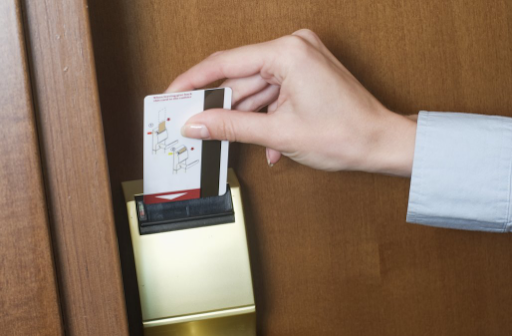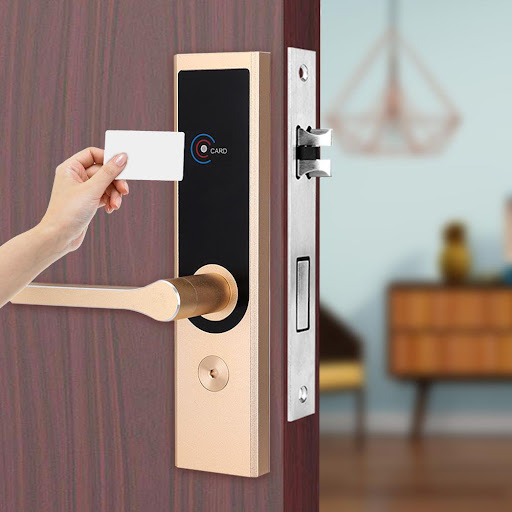RFID vs Magnetic Keycards & How to Go Digital
As magnetic stripe (magstripe) locks come to the end of their lifecycle, you need a clear understanding of what the benefits of the alternative RFID locks and keycards are, and of what functionality you’ll miss out on by not implementing a digital, mobile key solution.
In this article, we look at what separates RFID systems from magstripes, and how effective RFIDs and digital locks are at improving front desk operations and meeting modern guest expectations.
We also explain how you can turn your existing locks into digital (or smart) locks with Bluetooth Low Energy (BLE) functionality for mobile check-in at a fraction of the usual cost of replacing locks.
RFID and magnetic key cards explained
Here, we explain how Radio Frequency Identification (RFID) and magnetic strip (or magstripe) keycards and locks work before looking at why RFIDs are now the more popular choice.
What’s the difference between RFID and magstripe keycards?
Magstripe keycards have information uploaded onto the card’s magnetic strip at the front desk or at a check-in kiosk. They are then swiped or inserted into the magstripe reader which cross-checks this information with their programmed data. When there’s a match, the door will unlock.

RFID cards, on the other hand, don’t need to be swiped or inserted—guests just hold the card near to or against the reader for the door to unlock. Rather than a magnetic strip, information is uploaded to an RFID chip inside the keycard, while the lock is updated via a centralized system.


Some RFID locks also have Bluetooth Low Energy (BLE) functionality, which provides digital access to your guests, and remote access control to your management team.
When integrated with a guest management platform, this allows you to implement mobile check-in. We explore what this looks like in practice and why guests often prefer digital access later.
Why are RFID locks better than magstripe locks?
Though magstripe locks are typically cheaper, RFID locks provide a better experience for your team and guests. This is because magstripe cards:
- Can easily become demagnetized. For example, if they’re placed near a mobile phone, they may stop working.
- Increase the workload. Your team will have to clean them and upload new information onto them with each stay. RFID cards, on the other hand, can be updated remotely via management software.
- Don’t offer the same level of security. Magstripe locks can be hacked more easily than RFID lock systems because they aren’t encrypted.
Limits of RFID systems
RFID locks are better than magstripes because they’re more reliable and can have more automated processes built around them. But RFID locks still don’t solve all your guest experience and operational issues. In this section, we discuss why not, and look at what solution more effectively improves how guests begin their stay and your team’s efficiency.
Guests expect a frictionless experience
With the merging of the hotel and short-term rental (STR) markets, guests increasingly look to get from their hotel the same autonomy they experience with an STR. And RFID locks hold this back. This is because guests still have to collect their keycard, which means joining a line at the front desk or a check-in kiosk.
Mobile key, on the other hand, allows you to meet modern hotel guest expectations with a completely streamlined check-in experience. With BLE locks (we look at how to upgrade your locks below) and an integrated software solution like Operto Guest, check-in could look like this:
- After booking, guests receive an automated confirmation message with a link to a branded web app
- Here they see key information about their stay and start engaging with your brand and services
- They can use the web app to check in online, verify their identity, and complete a security deposit
- The guests then receives an automatically generated mobile key which is activated based on check-in time
- They can now arrive for their stay and go directly to their room, accessing it with the mobile key
Pro-tip: Inside the web app, you can create digital guidebooks that give your guests an easy way to find all the information they need—which will also save your front desk from handling most of the questions and inquiries that normally come their way. Here are some examples of what you can include in your branded digital guidebook:
|
Replacing lost keycards adds to staff workload
If you have manual processes for check-in and guest access, and have an understaffed front desk, your team can quickly become overwhelmed during busy periods. And any additional tasks, like responding to requests or replacing lost keycards, only add to your team’s stress.
With mobile check-in, though, your team and guests will encounter fewer bottlenecks. In fact, staff will be freed up to provide more attentive service and you won’t need to staff the front desk 24/7.
We recently spoke to Curtis Crimmins about how Roomza, a 60-room hotel with no front desk, operates successfully with this same mobile check-in solution.
Pro-tip: You can increase the efficiency of your cleaning operations by integrating occupancy information from your smart lock with scheduling software. For example, we can set up an automated alert to notify your cleaners as soon as a guest checks out, so no time is wasted once a room is available to turn over. |
Upgrade your locks for digital check-in and access
Replacing a keycard system with smart locks can be expensive. First, you have the cost of new commercial-grade locks, installation, and maintenance. Then you have to consider add-on costs, like door parts because of fire code requirements that kick in when you change hardware.
With Operto Boost, you can turn your existing locks into BLE smart locks for a fraction of the price of replacing them. The Boost Smart Chip can be used to upgrade most brands of commercial hotel locks—which means you keep the existing hardware, avoid having to replace door parts, and minimize installation costs.
Installing smart locks with Operto also gives you access to a suite of guest experience and management automation tools. You can:
- Instantly implement digital check-in for your guests
- Engage them in their stay pre-arrival with a branded digital guidebook
- Save your team time and stress with automated processes and centralized communications
The future of hotel room keycards
Just as magnetic stripe keycards have been replaced by RFID cards, smart locks are now replacing traditional RFID locks. This is because they facilitate mobile access and, with it, a more streamlined check-in experience, less work for your staff, and increased access control.
The problem is that replacing your locks is expensive. But the good news is Operto Boost provides a cost-effective way to upgrade your door locks.
Without changing out your hardware, you’ll get smart, BLE locks that enable mobile check-in and access with a suite of automation solutions that provide a beautifully streamlined experience for your team and guests.
Turn your existing locks into digital locks without the cost or hassle of replacing any hardware.